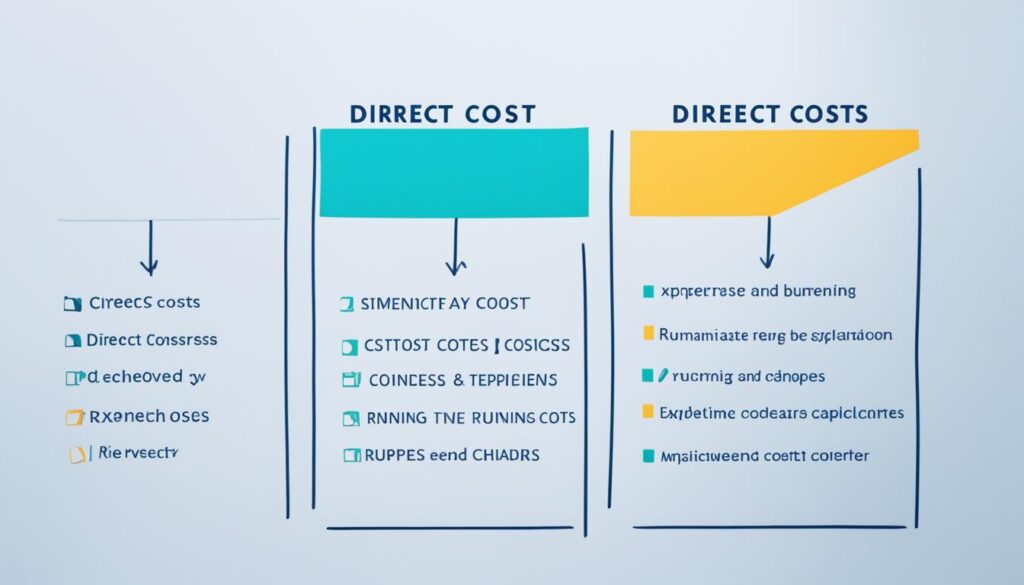Did you know that accurately identifying and calculating overhead costs is crucial to your business’s profitability? Failing to do so can result in charging too little for your products or services, directly impacting your bottom line.
Overhead costs include rent, insurance, and fees for professional services like legal or accounting advice. To calculate the overhead rate of your business, divide your total overhead costs by one or more allocation measures, such as direct costs, sales, or labor hours.
Key Takeaways:
- Accurately identify and calculate overhead costs to improve profitability.
- Overhead costs include rent, insurance, and fees for professional services.
- Calculate the overhead rate by dividing total overhead costs by allocation measures.
- Tracking overhead costs helps with budgeting, pricing, and increasing profitability.
- Reducing overhead costs can improve profit margins and identify cost-saving opportunities.
What are Overhead Costs?
Overhead costs are the indirect expenses of operating a business. These costs are essential for keeping your business running but are not directly related to creating a product or delivering a service. By understanding and accounting for overhead costs, you can accurately assess the overall expenses of your business.
Here are some examples of common overhead costs:
- Rent or mortgage payments
- Utility bills
- Mobile phone plans for employees
- Insurance
- Travel expenses
- Advertising and marketing expenses
- Office supplies
- Professional services like accounting and legal services
- Administrative or professional salaries
- Transportation costs
- Repairs and maintenance
- Depreciation
- Government fees and licenses
- Domain name and web hosting
- Software subscriptions
- Property taxes
It’s important to consider both overhead and direct costs when evaluating the overall financial health of your business.
| Expense Category | Examples |
|---|---|
| Rent or Mortgage Payments | Commercial space rental, property mortgage |
| Utility Bills | Electricity, water, gas |
| Mobile Phone Plans for Employees | Cell phone plans for staff members |
| Insurance | General liability insurance, property insurance |
| Travel Expenses | Airfare, hotel accommodations |
| Advertising and Marketing Expenses | Online ads, print ads, social media campaigns |
| Office Supplies | Paper, pens, printer ink |
| Professional Services | Accounting, legal advice |
| Administrative or Professional Salaries | Salaries of administrative staff or professionals |
| Transportation Costs | Vehicle maintenance, fuel expenses |
| Repairs and Maintenance | Building repairs, equipment maintenance |
| Depreciation | Decrease in value of assets over time |
| Government Fees and Licenses | Licensing fees, permits |
| Domain Name and Web Hosting | Website domain registration, website hosting |
| Software Subscriptions | Monthly software usage fees |
| Property Taxes | Taxes on owned properties |
Considering and managing overhead costs is crucial for maintaining a healthy financial foundation for your business.
Understanding Direct Costs and Overhead Costs
When it comes to running a business, it’s important to understand the distinction between direct costs and overhead costs. Direct costs are expenses that can be directly linked to the production of a product or the delivery of a service. These costs include materials, labor, and any other expenses that directly contribute to the creation and distribution of your offerings.
On the other hand, overhead costs are the expenses that are necessary to keep your business running smoothly but are not directly tied to your core product or service. These costs include rent, utilities, insurance, office supplies, and other administrative expenses. While direct costs are closely tied to sales and revenue generation, overhead costs are essential for supporting the overall profitability of your business.
Tracking and managing overhead costs is crucial for several reasons. First, understanding your overhead costs allows you to properly price your product or service. By factoring in overhead costs, you can ensure that your pricing accurately reflects the true cost of production. This helps you avoid undercharging for your offerings and potentially eroding your profit margins.
Additionally, tracking overhead costs allows you to identify areas where cost savings can be achieved. By analyzing your overhead expenses, you can identify opportunities to reduce unnecessary expenses, negotiate better contracts with suppliers, or implement efficiency measures that streamline your operations. These cost-saving efforts contribute to improving your overall profitability.
It’s worth noting that some expenses can fall into both the direct costs and overhead costs categories, depending on their specific nature and usage within your business. For example, certain labor costs may be considered direct costs if they are directly involved in the production process, while the same labor costs may be classified as overhead costs if they support the overall operations of the business.
By understanding the distinction between direct costs and overhead costs and effectively managing both, you can optimize your business’s financial performance and ensure long-term success.

Calculating Overhead Rate
The overhead rate calculates overhead costs as a percentage of other metrics like direct costs, sales, or labor hours. To calculate the overhead rate, divide your total overhead costs by the allocation measure you choose to compare with, such as direct costs, labor hours, machine hours, or sales. The right metric to use depends on the nature of your business.
Choosing the Right Allocation Measure
For example, construction companies may compare overhead costs with the cost of raw materials and direct labor, while large manufacturing businesses may use machine or labor hours. A combination of several different allocation measures can be used to understand overhead costs.
Calculating the overhead rate helps you determine how much of your total costs are attributed to overhead expenses. This information enables you to make informed decisions about pricing, budgeting, and cost optimization.

| Allocation Measure | Formula |
|---|---|
| Direct Costs | Total Overhead Costs / Total Direct Costs |
| Labor Hours | Total Overhead Costs / Total Labor Hours |
| Machine Hours | Total Overhead Costs / Total Machine Hours |
| Sales | Total Overhead Costs / Total Sales |
By analyzing the results, you can gain insights into which allocation measures have the most significant impact on your overhead rate. This information can guide your decision-making process and help you identify potential areas for cost reduction and efficiency improvement.
Determining the Acceptable Overhead Rate
In order to assess the financial health of your business, it is essential to determine the acceptable overhead rate. This rate depends on various factors such as the nature of your product or service and the industry in which you operate. To get a better understanding of what constitutes an ideal overhead rate for your business, it is helpful to compare it with the industry average. By doing so, you can gauge where your business stands in terms of overhead costs and profitability.
Typically, a healthy overhead rate is considered to be less than 35%. This means that your overhead costs should ideally account for less than 35% of your total operating expenses. Maintaining a lower overhead rate allows for higher profitability and financial stability.
To accurately determine your overhead rate, it is advisable to seek the guidance of an experienced accountant. They can analyze your business’s specific situation and advise you on the most appropriate metrics to use when calculating the overhead rate.
By carefully tracking and analyzing your overhead costs, you can identify areas where cost reduction is possible. This, in turn, can significantly improve your profit margins and overall business profitability.
| Industry | Average Overhead Rate |
|---|---|
| E-commerce | 25% |
| Manufacturing | 20% |
| Construction | 30% |
| Consulting | 18% |
The table above provides a glimpse into the average overhead rates for various industries. Please note that these figures may vary depending on numerous factors, including business size and geographical location. Comparing your business’s overhead rate with the industry average can give you valuable insights and help you better assess your financial performance.
Reducing Overhead Costs
To drive profitability and increase the bottom line, businesses must prioritize cost-saving measures to reduce overhead costs. By implementing strategic cost-cutting initiatives, businesses can optimize their operations and improve financial performance. Here are some effective strategies to reduce overhead costs:
- Review Expenses: Conduct a thorough review of all expenses to identify areas where costs can be eliminated or minimized. Scrutinize each expense category and determine if it is essential to the core operations of the business.
- Hire a Professional Accountant: Engage the services of a professional accountant who specializes in expense management. They can offer expert advice on reducing costs, optimizing resources, and maximizing tax deductions.
- Optimize Premises: Consider relocating to more cost-effective premises or negotiating better lease agreements to lower rental expenses. Additionally, evaluate the need for office space and explore remote work options to save on office space costs.
- Reduce Utility Costs: Implement energy-efficient practices and technologies to lower utility bills. Encourage employees to adopt energy-saving habits, such as turning off lights and equipment when not in use.
- Outsource Non-Core Functions: Determine if certain non-core functions can be outsourced to external service providers. This can help reduce staffing and infrastructure costs while ensuring efficient and cost-effective service delivery.
Case Study: Reducing Office Supply Costs
“By implementing a centralized procurement system and negotiating bulk purchasing agreements, Company XYZ successfully reduced their office supply costs by 30%. They also encouraged employees to practice responsible consumption and waste reduction, resulting in additional savings.”
By carefully managing overhead costs and implementing cost-saving measures, businesses can enhance their profitability while maintaining operational efficiency. Regularly review and reassess your overhead expenses to identify potential areas for optimization and improvement. Through smart cost management, businesses can achieve sustainable growth and financial success.
Conclusion
Calculating running costs of a business efficiently is essential for effective financial management and decision-making. By accurately identifying and calculating overhead costs, businesses can gain valuable insights into their profitability and make informed budgeting and pricing decisions. Tracking and analyzing overhead costs allows for the allocation of a portion of the overhead to each unit produced, enabling businesses to account for these costs in the pricing of their products or services. This strategic approach encourages a more accurate and profitable assessment of the business’s financial performance.
In addition, reducing overhead costs can significantly improve profit margins and unveil areas for cost optimization. By closely managing expenses and employing cost-saving measures, businesses can not only control spending but also increase their profitability. Proactive expense tracking and budget planning play a vital role in successful business expenditure calculation, ensuring financial resources are utilized effectively and efficiently.
Overall, the accurate calculation of business costs, effective financial management, and diligent expense tracking are crucial for long-term success and growth. By implementing these strategies, businesses can optimize their resources, make informed decisions, and enhance profitability. Thoughtful consideration of overhead costs and diligent expense tracking contribute to improved financial stability and pave the way for future business success.
FAQ
How do I calculate the running costs of my business efficiently?
To calculate the running costs of your business efficiently, start by identifying and tracking your overhead costs. These include expenses such as rent, insurance, and professional services. Then, divide your total overhead costs by one or more allocation measures, such as direct costs, sales, or labor hours, to calculate the overhead rate. This will help you budget, price your products or services, and increase profitability.
What are overhead costs?
Overhead costs are the indirect costs of operating a business. They include any expenses that keep your business running but aren’t directly related to creating a product or delivering a service. Examples of overhead costs include rent or mortgage payments, utility bills, insurance, advertising and marketing expenses, office supplies, professional services, salaries, transportation costs, and property taxes.
What is the difference between direct costs and overhead costs?
Direct costs are directly connected to the output of a product or service, such as labor and materials. Overhead costs, on the other hand, are the costs that keep your business running but aren’t directly related to creating a product or delivering a service. While direct costs are linked to sales, overhead costs support profit-making activities. Some costs can be categorized as both direct costs and overhead costs, depending on their nature and usage.
How do I calculate the overhead rate?
To calculate the overhead rate, divide your total overhead costs by the allocation measure you choose to compare with, such as direct costs, labor hours, machine hours, or sales. The right metric to use depends on the nature of your business. For example, construction companies may compare overhead costs with the cost of raw materials and direct labor, while large manufacturing businesses may use machine or labor hours. A combination of several different allocation measures can be used to understand overhead costs.
What is the acceptable overhead rate for my business?
The acceptable overhead rate for your business depends on the nature of your product or service and your industry. It is useful to compare your overhead rate with the industry average to gauge an ideal overhead rate. Generally, an overhead rate of less than 35% is considered healthy. An accountant can assess your business’s situation and advise you on the best metric to use for calculating the overhead rate.
How can I reduce my overhead costs?
To reduce your overhead costs, closely review all your expenses and determine if you can eliminate certain expenses or take cost-saving measures. Engaging a professional accountant can also help identify areas to reduce expenses or maximize tax deductions. Finding more affordable premises and optimizing utilities can contribute to cost reduction. By carefully managing your overhead costs, you can improve your profit margins and identify which products or services are most profitable for your business.
Why is it important to calculate and track the running costs of a business?
Calculating and tracking the running costs of a business is essential for financial management and decision-making. It allows you to accurately understand your business’s profitability, make informed budgeting and pricing decisions, and allocate overhead costs to each unit produced. Additionally, reducing overhead costs can improve your profit margins and identify areas for cost optimization. Effective expense tracking and budget planning are crucial for successful business expenditure calculation.


